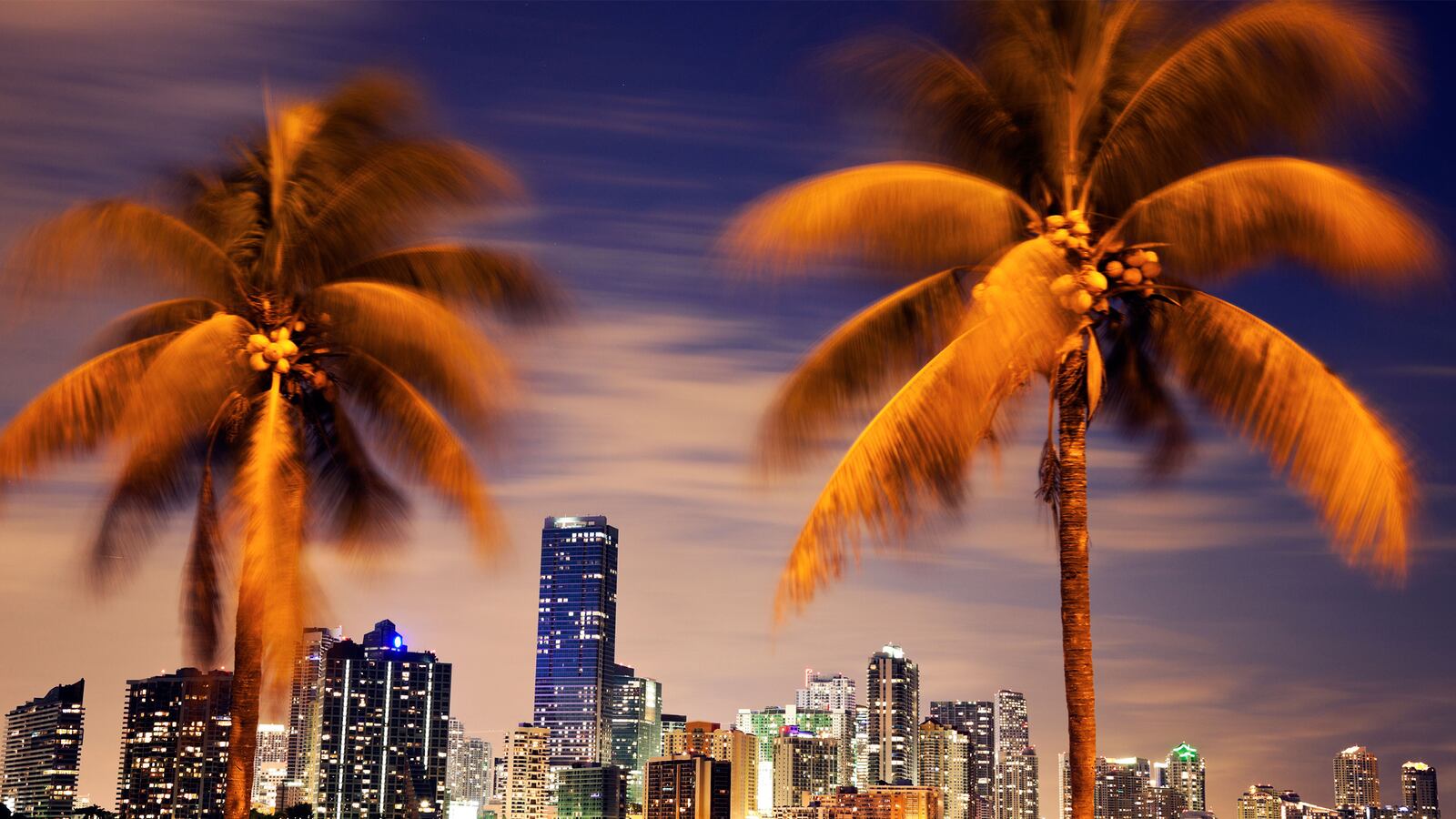You feel a slight sheen of sweat on your brow. You take a long pull from your Cuba Libre as you lean back in your chair, your feet sliding over the warm sand. You can still taste the heavy bistec empanizado lunch you downed an hour before, capped by a potent cafecito. You watch the tan, toned men and women in their tight bathing suits walk across the beach. Celia Cruz is playing somewhere in the distance and you don’t have a care in the world. This is the life. The Magic City.
Welcome to Miami. Welcome to paradise.
A few miles from the sweaty, rhythmic hustle and bustle of South Beach, a man takes a picture of his murdered wife and posts it on Facebook. On the west end of the MacArthur Causeway, as cars whizz by, a drug-crazed maniac is shot dead after chewing the face off an unsuspecting homeless guy. Somewhere in Liberty City, a self-proclaimed prophet meets with his followers behind closed doors and asks them to kill for him, in the name of God.
A crowded Dadeland Mall parking lot becomes a warzone as three machine-gun toting hit men open fire on a crew of rival dealers in broad daylight, on the orders of their cartel boss—their Godmother. Off Okeechobee Road in Hialeah, an ex-Soviet citizen makes a living as a strip club owner who also happens to be part pimp, bouncer, drug dealer, and human trafficker, using young girls brought in illegally to work at his dive venue. A disgraced politician walks into the lobby of the city’s biggest newspaper and blows his brains out. Back on the beach, a world-renowned fashion designer is gunned down on the front steps of his SoBe mansion.
Even paradise can be deadly.
Miami has always had a dual nature—its beautiful veneer masking a sometimes-corrupt and dangerous underbelly. From the Spanish conquistadors that slaughtered the indigenous cultures to “discover” Miami to early 20th century police officers moonlighting as members of the KKK to providing shelter for legendary gangsters like Meyer Lansky and Al Capone to the race riots and drug war-related bloodshed of the last 25 years, Miami has the makings of a beautiful, lethal weapon—easy on the eyes but very risky. Handle with care.
What better place to set a series of crime novels? From serial killers to mobsters, Miami has it all with a pastelito de guayaba.
When I decided I wanted to write mystery novels, there was no question where they would be set, even before I’d zeroed in on the characteristics that would combine to create my series protagonist, washed up ex-journalist Pete Fernandez. It had to be Miami, my hometown, where I was born and raised.
I wanted my books—including my debut Silent City and its just-released sequel, Down the Darkest Street—to evoke a strong sense of location. I wanted the city I loved to be as relevant as any character, even if the town was a little sunburnt and shady. I wanted Pete to explore the corners of the city that sometimes got ignored—the poor areas, the dangerous, and the forgotten. I wanted the Miami of the Pete Fernandez mysteries to resonate as loudly as those private eye books I couldn’t put down.
Even cheerful moments growing up—beach trips, family parties—were coated by a feeling of anxiety, a sense that something sinister could crop up at any time. My blurred childhood memories of the evening news—The McDuffie Riots, Dadeland Massacre, Yahweh Ben Yahweh, Danny Rolling—all took up real estate in my young mind, propelling me to devour The Miami Herald metro section each morning and true crime and pulp novels at night. I spent decades doing research, stockpiling ideas and characters that only Miami could produce.
There could be no Philip Marlowe without Raymond Chandler’s gimlet-fueled, hazy Los Angeles—a fading, already-tarnished Hollywood, its gold paint hastily masking a chipped facade. There’d be no Matt Scudder without Lawrence Block’s jagged asphalt maze, his dark New York streets caked with blood under gray clouds. Could Tess Monaghan exist without the quirks, characters and pitfalls of her murder-happy Baltimore hometown? Certainly not. Place matters, especially in the crime novel—and there’s no place like Miami. Hot, dangerous, sweet, sexy, decadent and one of a kind.
Miami: complex, multicultural, visceral and vibrant—a bustling doorway to Latin America, a city built by migrants looking for a warm weather escape and immigrants desperate for something that resembled home. It’s easy to be lulled by the Caribbean breeze and beautiful sights, but Miami can be lethal, too, its urban sprawl littered with illicit deals, shocking scandals and seething corruption—a collection of dark tales and only-in-Miami stories illuminated by the flickering neon signs that line the streets. It’s no wonder that every portrayal of the city in other media seems strikingly different, yet alarmingly accurate. Whether it’s the pastel colored suits and sports cars of Miami Vice, the glamour-and-crime cocktail of Charles Willeford’s Hoke Moseley novels, or the cocaine-smeared overkill of a machine gun-toting Tony Montana in Scarface, Miami is bursting with stories to tell.
Miami isn’t just your average U.S. city, and there’s more to it that rests beyond the palm trees and mixed drinks. Look more closely and you’ll find a feverishly complex metropolis, vibrant and teeming with history, people and culture. But it is not without blemishes and scars, and those cuts, wounds, and scrapes leave a trail of blood that makes for killer crime stories.
Alex Segura is a novelist and comic book writer. His Miami crime novels Silent City and Down the Darkest Street, featuring washed up journalist Pete Fernandez, are out now from Polis Books. You can find him at alexsegura.com or on Twitter @alex_segura.




